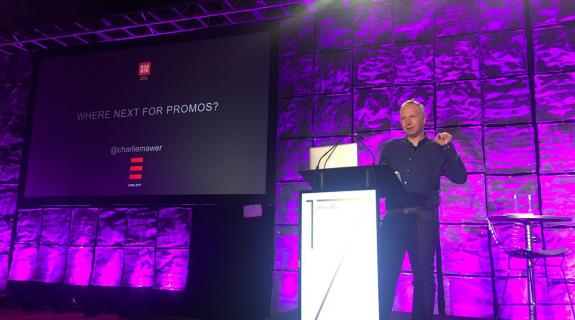It used to be so simple.
When Red Bee Creative Executive Creative Director Charlie Mawer first entered the realm of television marketing, in 1994, a show’s promo campaign generally consisted of the following elements:
:60 Launch Spot for Debut
:30 Edited Version of Launch Spot
:10 Edited Version of Launch Spot
:20 Tune-In Spots for Subsequent Eps
Shockingly, that is still how many promo campaigns unfurl, more or less, with traditional linear elements still orchestrated around rigid premiere dates. “Streaming services have no obligation to such dates,” Mawer told a packed house at PromaxBDA: The Conference on Thursday, “and it’s killing us.”
Today’s consumers, Mawer continued, treat their viewing experience as a “journey to commitment,” approaching the watching of anything with tremendous trepidation. These ultra-careful viewers, who may track down everything there is about a show before taking in the show itself, “enjoy the chase” as much as they do the prize.
“The single biggest mind-shift for marketers,” Mawer proclaimed, is: “It’s not the tease anymore that they want; it’s the reveal. The more you can share, the better. Forget about spoilers. Share, share and over-share.”
To that end, what follows are Charlie Mawer’s 10 elements for a successful promo campaign in the modern age:
1) Tease the Trailer
We live in a post-trailer age. The trailer has become an event in itself and today’s savvy marketers will honor that by releasing a promo for said trailer – a trailer-teaser-trailer, if you will.
2) Early Date Announcement
“Streaming services don’t have schedules,” Mawer said. They can announce show launches months, even years in advance, building anticipation earlier than ever before. Stranger Things, for instance, announced its Season 2 premiere—happening on Halloween, 2017—during the latest Super Bowl… which aired back in February, nine months before we’ll ever get to watch the thing.
3) Influencer Content
To reiterate: “Share absolutely everything and share it early,” Mawer said. Behind-the-scenes content, on-set photos, makings-of. You name it, you share it, and get it in the hands of the people who want to share it, too. “Influencers can be anywhere and everywhere,” Mawer said. BBC, for instance, creates “Live Lessons” for classrooms based around shows that merit them, such as a computer class inspired by Dr. Who. Few influencers are more passionate than a room full of excited kids.
4) Planned Spontaneity
Or, as Mawer put it, the act of “riding cultural momentum,” which involves pairing your promos, or even the show itself, with real-world happenings. Just look at National Geographic’s (literally genius) Genius spot featuring Einstein playing the music of Lady Gaga, which debuted immediately following her halftime performance during, once again, the latest Super Bowl broadcast:
5) Targeted Thematics
The Crown’s political intrigue. House of Cards’ political intrigue. Game of Thrones’… political intrigue. Is everything these days about political intrigue or are we just reading into it? Sure, there are other themes, too, and whichever ones fit your show, it’s more important than ever before to hone in on them, as Red Bee did recently with a series of several themed trailer edits for The Crown.
6) Live Spike
“In a world where social is increasingly driving engagements, live video should be viewed as a massive part of the mix,” Mawer said. Queen of all Social Facebook, for instance, now promotes live video more than anything else, which means your spot taking place in real time will get more traffic there than the one which does not.
7) Personalized Targeting
This is where things start to get a little scary. “We are moving closer and closer to a world where spots are made specifically for you,” Mawer said. You can’t escape it, so why fight it? Smart promos can now target increasingly tight geographical areas, running spots during breaks tailored to, say the citizens of one small town, and something different for the next town over. Then there are the things that just straight up talk to you, Minority Report-style:
8) Preview Plus
“The goal is to reward fans with extra content” in addition to promos, Mawer said. Who wants to just sit and watch a trailer anymore? We want to do stuff, to find and play and explore and discover. We are all children inside with an insatiable hunger for discovery and your promo campaign could be our playground. Even cooler, the sky’s the limit here on what you can do to engage viewers in new and surprising ways. Check out Red Bee’s astonishing immersive stunt for Fox Networks Group’s Outcast, for instance, wherein 12 show-specific, commissioned artworks were unveiled in 12 different cities, and fans could unlock even more content by visiting the site of each one in person.
9) Vertical Versions
From tiny watch screens to triple-display laptops, the array of sizes on which we watch gets more complicated every day. This bummed Mawer out at first, but after stumbling across an actual vertical film festival, he realized “it’s just another art form, another thing we can use creatively in our campaigns.” So use it already.
10) Branded Tune-In
Self-explanatory but easy to lose track of. As “campaigns get longer, more diverse, more fragmented,” Mawer said, don’t ever, ever, ever “forget you have to stay on brand.”
Tags:













































__twocolumncontent.jpg)











